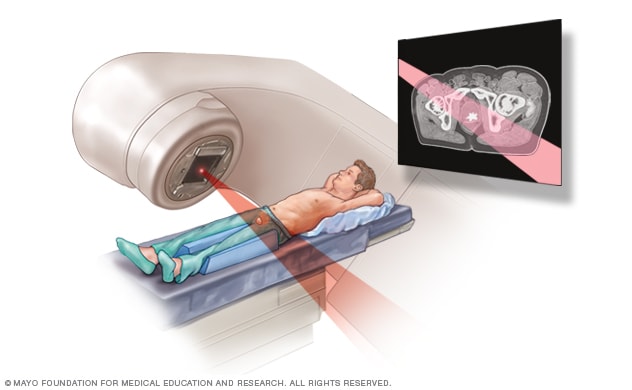Overview
External beam radiation for prostate cancer

External beam radiation for prostate cancer
During external beam radiation treatment for prostate cancer, you lie on a table while a linear accelerator moves around you to deliver radiation from many angles. The linear accelerator delivers the precise dose of radiation planned by your treatment team.
External beam radiation for prostate cancer uses high-energy beams, such as X-rays or protons, to kill cancer cells. During the treatment, the high-energy beams are generated by a machine called a linear accelerator that aims the beams at your prostate gland.
External beam radiation for prostate cancer kills cancer cells by destroying the genetic material that controls how cells grow and divide. Healthy cells in the beam's path also are affected by the radiation, resulting in side effects. The goal of treatment is to destroy the cancerous cells while sparing as much of the normal surrounding tissue as possible.
External beam radiation for prostate cancer is one of the standard treatment options to treat prostate cancer. It may also be used if you have prostate cancer that comes back after surgery.
Products & Services
Why it's done
Your doctor may recommend external beam radiation for prostate cancer as an option at different times during your cancer treatment and for different reasons, including:
- As the only (primary) treatment for cancer, usually for early-stage cancer that is confined to your prostate
- In combination with other treatments, such as hormone therapy, for more-serious cancer that's still confined to your prostate
- After surgery, to reduce the risk of cancer returning (adjuvant therapy)
- After surgery, when there is indication that your cancer has recurred either in the form of increased levels of prostate-specific antigen (PSA) in your blood or signs of cancer in your pelvis
- To alleviate symptoms, such as bone pain, caused by advanced cancer that has spread beyond the prostate
Risks
The type and severity of side effects you have with external beam radiation for prostate cancer may depend on the dose and on the amount of healthy tissue that's exposed to the radiation. Most side effects are temporary, can be controlled and generally improve over time once treatment has ended.
Potential side effects of external beam radiation therapy for prostate cancer may include:
- Frequent urination
- Difficult or painful urination
- Blood in the urine
- Urinary leakage
- Abdominal cramping
- Diarrhea
- Painful bowel movements
- Rectal bleeding
- Rectal leaking
- Fatigue
- Sexual dysfunction, including diminished erectile function or decrease in the volume of semen
- Skin reactions (similar to a sunburn)
- Secondary cancers in the region of the radiation
Most of the side effects are mild and tolerable. Some side effects may develop months to years later. Serious late side effects aren't common. Ask your doctor about potential side effects, both short- and long-term, that may occur during and after your treatment.
How you prepare
Before you undergo external beam radiation therapy for prostate cancer, your health care team guides you through a planning process to ensure that radiation reaches the precise spot in your body where it's needed.
Planning typically includes:
-
Radiation simulation. During simulation, your radiation therapy team works with you to find a comfortable position for you during treatment. It's crucial that you lie still during radiation treatment, so finding a comfortable position is vital.
Customized immobilization devices are used to help you hold still in the right position. Your radiation therapy team will make marks on your body to be used for setup during your radiation therapy sessions.
- Planning scans. Your radiation therapy team may perform computerized tomography (CT) scans to determine the exact area of your body to be treated.
After the planning process, your radiation therapy team decides what type of radiation and what dose you'll receive based on your stage of cancer, your general health and the goals for your treatment.
What you can expect
External beam radiation for prostate cancer is conducted using a linear accelerator — a machine that directs high-energy beams of radiation into your body. As you lie on a table, the linear accelerator moves around you to deliver radiation from many angles. The linear accelerator delivers the precise dose of radiation planned by your treatment team.
External beam radiation therapy is typically:
- Given on an outpatient basis
- Administered five days a week over several weeks
Each treatment session usually lasts less than an hour. Most of that is preparation time. The actual radiation treatment only takes a few minutes.
During a treatment session:
- You lie down in the position determined during your radiation simulation session.
- You might be positioned with customized immobilization devices to hold you in the same position for each therapy session.
- The linear accelerator machine may rotate around your body to deliver radiation beams from different directions.
- You lie still and breathe normally during the treatment.
- Your radiation therapy team stays nearby in a room with video and audio connections so that you can talk to each other.
- You shouldn't feel any pain. Speak up if you don't feel comfortable.
Results
After your external beam radiation therapy is complete, you will have regular follow-up appointments with your doctor to evaluate how your cancer has responded to the treatment.